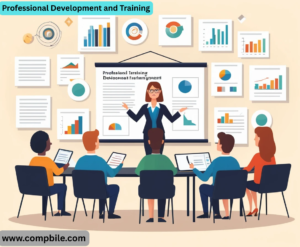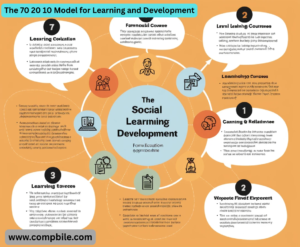Professional Development and Training Of course. Here is a comprehensive overview of Professional Development and Training, covering its importance, types, strategies for implementation, and future trends.
Professional Development and Training: A Strategic Guide
- Professional Development and Training refer to the ongoing process of acquiring new skills, knowledge, and competencies to enhance an individual’s performance and advance their career. It’s a strategic investment for both the employee and the organization.
Why is it So Important?
For Employees:
- Career Advancement: Opens doors to promotions, new roles, and increased responsibilities.
- Increased Job Satisfaction & Engagement: Shows that the company invests in its people, leading to higher morale and loyalty.
- Improved Confidence: Mastery of new skills boosts self-efficacy and performance.
- Future-Proofing: Helps employees adapt to industry changes and technological disruptions.
For Employers:
- Increased Productivity & Performance: Skilled employees work more efficiently and effectively.
- Talent Attraction & Retention: A strong learning culture is a key differentiator for top talent.
- Succession Planning: Develops a pipeline of qualified internal candidates for leadership roles.
- Innovation: A learning environment encourages new ideas and creative problem-solving.
- Compliance & Risk Management: Ensures employees are trained on necessary regulations (e.g., safety, ethics, data security).
Creating an Effective Program (For Organizations)
- A successful strategy is aligned with business goals and employee aspirations.
Needs Assessment:
- Organizational Level: What skills are needed to achieve our strategic goals?
- Task/Team Level: What skills are missing for specific projects or roles?
- Individual Level: What do employees want to learn? (Use performance reviews, skills gap analyses, and surveys).
Set Clear Objectives:
- Define what success looks like using the SMART framework (Specific, Measurable, Achievable, Relevant, Time-bound).
- Example: “Increase sales team proficiency in our new CRM, resulting in a 10% reduction in data entry time within Q3.”
Leverage Technology Learning Management Systems LMS
- An LMS (e.g., Docebo, Cornerstone, TalentLMS) helps administer, track, and deliver training efficiently. It’s essential for scaling programs, especially in hybrid/remote work environments.
Encourage a Culture of Learning:
- Leadership Buy-in: Leaders must champion and participate in learning.
- Dedicated Time & Budget: Allocate specific hours and financial resources for development.
- Recognize & Reward: Celebrate learning milestones and application of new skills.
Measure ROI and Effectiveness:
Use the Kirkpatrick Model to evaluate training:
- Level 1: Reaction – Did employees enjoy the training? (Surveys)
- Level 2: Learning – Did they acquire the intended knowledge/skills? (Quizzes, assessments)
- Level 4: Results – Did it impact business metrics? (Increased sales, improved quality, reduced costs)
Taking Charge of Your Own PD (For Individuals)
Your growth is ultimately your responsibility.
- Self-Assessment: Identify your strengths, weaknesses, and interests. What do you enjoy? What skills are needed for your dream job?
- Set Career Goals: Where do you want to be in 1, 3, or 5 years? Your goals will dictate your learning path.
- Seek Feedback: Regularly ask your manager, peers, and mentors for input on areas for improvement.
- Create a Personal Development Plan (PDP): Outline the skills you need to develop, the resources required, and a timeline. Discuss this plan with your manager.
- Be Proactive: Don’t wait for opportunities. Volunteer for new projects, ask to sit in on meetings, and share your learning goals with your network.
- Dedicate Time: Block out time in your calendar each week for learning, even if it’s just 30 minutes.
Future Trends in Professional Development
- Microlearning: Bite-sized, focused learning modules (5-10 minutes) for just-in-time knowledge.
- Personalization & AI: AI-driven platforms curate personalized learning paths based on your role, goals, and learning habits.
- Focus on Power Skills (Soft Skills): Increased emphasis on critical thinking, communication, adaptability, and emotional intelligence as automation handles more technical tasks.
- Virtual Reality (VR) & Augmented Reality (AR): Used for immersive training in high-risk or complex scenarios (e.g., surgery, equipment repair, public speaking practice).
- Data-Driven Learning: Using analytics to understand skill gaps across the organization and measure the direct impact of training on performance.
Advanced Models and Frameworks for Effective Training
- Understanding these models can help structure and evaluate PD programs more effectively.
The 70 20 10 Model for Learning and Development
This is a widely referenced framework that suggests how people learn effectively in the workplace:
- 70% from Challenging Assignments (On-the-Job Experiences): This is the most significant part. Learning happens by doing, tackling new projects, solving problems, and taking on stretch assignments.
- 20% from Developmental Relationships (Social Learning): Learning from others through coaching, mentoring, feedback, and collaborative work.
- 10% from Formal Training Courses (Structured Education): The smallest but still crucial slice comes from workshops, courses, and reading.
- Implication: The best PD strategies don’t just fund online courses; they create a culture rich in on-the-job challenges and supportive relationships.
ADDIE Model
This is a classic, systematic instructional design framework used to develop effective training programs:
- Analyze: Identify the problem, target audience, and learning goals.
- Design: Plan the learning objectives, content, exercises, and assessment criteria.
- Develop: Create the actual training materials (videos, workbooks, presentations, e-learning modules).
- Implement: Deliver the training to the participants.
- Evaluate: Measure the effectiveness and make necessary improvements.
Bloom’s Taxonomy
It helps designers create training that moves beyond simple memorization:
- Remembering: Recall facts and basic concepts.
- Understanding: Explain ideas or concepts.
- Applying: Use information in new situations.
- Analyzing: Draw connections among ideas.
- Evaluating: Justify a stand or decision.
- Creating: Produce new or original work.
- Implication: Effective training should aim for the higher levels (Apply, Analyze, Evaluate, Create) to ensure real behavioral change.
Specialized Areas of Professional Development
Beyond general skills, PD often focuses on key areas:
- Leadership Development: Crucial for succession planning. Programs focus on strategic thinking, emotional intelligence, giving feedback, managing change, and motivating teams. Examples: High-potential (HiPo) programs, executive coaching.
- Onboarding: The most critical PD for new hires. Effective onboarding goes beyond paperwork to acculturate new employees, connect them to networks, and set them up for productivity.
- Compliance Training: Mandatory training on topics like ethics, workplace safety (OSHA), cybersecurity awareness, and harassment prevention. The challenge is making this engaging rather than a checkbox exercise.
- Technical & Technology-Specific Training: Keeping pace with new software, tools, and technical certifications required for specific roles (e.g., cloud computing certifications, new programming frameworks, SEO best practices).
- “Power Skills” (Soft Skills) Development: The demand for skills like communication, collaboration, creativity, and adaptability is higher than ever.
The Individual’s Toolkit: Practical Next Steps
If you’re an individual looking to advance, here’s a actionable checklist:
- Conduct a Skills Audit: Compare your current skills against job descriptions for the role you want next. Identify the gaps.
Find a Mentor and a Sponsor:
- A Mentor offers advice and guidance.
- A Sponsor is in a position of power and actively advocates for your promotions and key assignments. Cultivate both relationships.
- Build a “Learning Portfolio”: Don’t just list “Completed Course X” on your resume. Create a portfolio that showcases projects where you applied what you learned. This could be a GitHub repo, a writing sample, a case study, or a portfolio website.
- Engage in Professional Associations: Join groups like SHRM (for HR), PMI (for project managers), or industry-specific associations. Attend their events and network.
- Request Feedback Specific to Growth: Instead of asking “How am I doing?”, ask “What’s one skill you think I should develop to advance to the next level?




